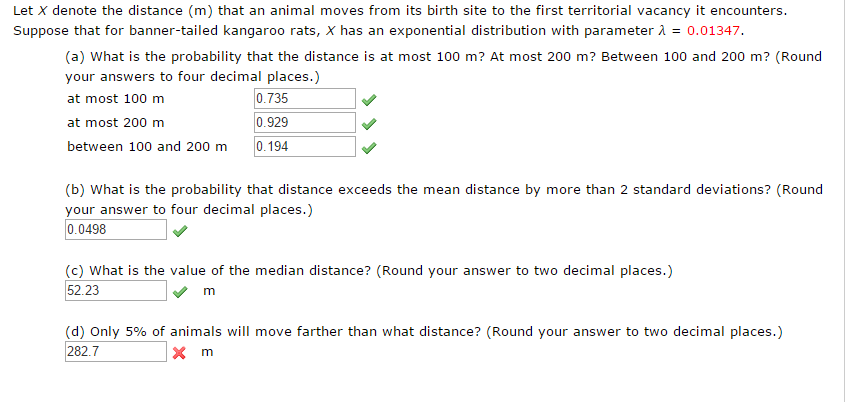Let X denote the distance m that an animal moves from its birth site to the first territorial vacancy it encounters. At most 200 m.

Solved Let X Denote The Distance M That An Animal Moves Chegg Com
Suppose that for banner-tailed kangaroo rats X has an exponential distribution with parameter A 001427.

. Let X denote the distance m that an animal moves from its birth site to the first territorial vacancy it encounters. Let X denote the distance m that an animal moves from its birth site to the first territorial vacancy it encounters. Let x denote the distance m that an animal moves from its birth site to the first territorial vacancy it encounters.
Suppose that for banner-tailed kangaroo rats X has an exponential distribution with parameter l 5 01386 as suggested in the article Competition and Dispersal from Multiple Nests Ecology 1997. Suppose that for banner-tailed kangaroo rats x has an exponential distribution with parameter l 5 01386 as suggested in the article competition and dispersal from multiple nests ecology 1997. Let X denote the distance m that an animal moves from its birth site to the first territorial vacancy it encounters.
Let X denote the distance m that an animal moves from its birth site to the first territorial vacancy it encounters. Let X denote the distance m that an animal moves from its birth site to the first territorial vacancy it encounters. At most 200 m.
Suppose that for banner-tailed kangaroo rats X has an exponential distribution with parameter. Let X denote the distance m that an animal moves from its birth site to the first territorial vacancy it encounters. 2 Let X denote the distance m that an animal moves from its birth site to the first territorial vacancy it encounters.
Suppose that for banner-tailed kangaroo rats X has an exponential distribution with parameter 2 001437. Suppose that for banner-tailed kangaroo rats X has an exponential distribution with parameter λ 001352. A What is the probability that the distance is at most 100 m.
A What is the probability that the distance is at most 100 m. Suppose that for banner-tailed kangaroo rats x has an exponential distribution with parameter l 5 01386 as suggested in the article competition and dispersal from multiple nests ecology 1997. Between 100 and 200 m.
Suppose that for banner-tailed kangaroo rats X has an exponential distribution with parameter 1 001347. We can write the problem US probability X minus mu straighter. Suppose that for banner-tailed kangaroo rats X has an exponential distribution with parameter lambda01386 as suggested in the article Competition and Dispersal from.
At most 200 m. Between 100 and 200 m. A What is the probability that the distance is at most 100 m.
Let X denote the distance m that an animal moves from its birth site to the first territorial vacancy it encounters. Let X denote the distance m that an animal moves from its birth site to the first territorial vacancy it encounters. Suppose that for banner-tailed kangaroo rats has an exponential distribution with parameter λ 01386as suggested in the article Competition and Dispersal from Multiple Nests.
A What is the probability that the distance is at most 100 m. 460 Let X denote the distance m that an animal moves from its birth site to the first territorial vacancy it encounters. Suppose that for banner-tailed kangaroo rats X has an exponential.
Suppose that for banner-tailed kangaroo rats X has an exponential distribution with parameter λ 001412. Suppose that for banner-tailed kangaroo rats X has an exponential distribution with parameter λ 01386as suggested in the article Competition and Dispersal from Multiple Nests Ecology 1997. Let X denote the distance m that an animal moves from its birth site to the first territorial vacancy it encounters.
Let X denote the distance m that an animal moves from its birth site to the first territorial vacancy it encounters. Answer of Let x denote the distance m that an animal moves from its birth site to the first territorial vacancy it encounters. A What is the probability that the distance is at most 100 m.
Let x denote the distance m that an animal moves from its birth site to the first territorial vacancy it encounters. Let X denote the distance m that an animal moves from its birth site to the first territorial vacancy it encounters. Suppose that for banner-tailed kangaroo rats X has an exponential distribution with parameter λ 001342.
Suppose that for banner-tailed kangaroo rats X has an exponential. Suppose that for banner-tailed. We were asking for the probability that the distance exits the mean distance by more than a standard divisions.
Suppose that for banner-tailed kangaroo rats X has an exponential distribution with parameter 1 001332. Suppose that x has an exponential distribution with parameter lambda 001386. At most 200 m.
Between 100 and 200 m. Let X denote the distance m that an animal moves from its birth site to the first territorial vacancy it encounters. Suppose that for banner-tailed kangaroo rats X has an exponential distribution with parameter Î 001372.
So from here we know that the mean and the standard deviation off exponential distributions are equal to one over London. Let x denote the distance that an animal moves from its birth site to the first territorial vacancy it encounters. Between 100 and 200 m.
The exact P10 X 15 binomcdf25 p 15 - binomcdf25 p 9 4. Suppose that for banner-tailed kangaroo rats X has an exponential distribution with parameter a 001342. Find step-by-step Probability solutions and your answer to the following textbook question.
Let X denote the distance m that an animal moves from its birth site to the first territorial vacancy it encounters. Suppose that for banner-tailed kangaroo rats X has an exponential distribution with parameter λ 01386 as suggested in the article Competition and Dispersal from Multiple Nests Ecology 1997. Let X denote the distance m that an animal moves from its birth site to the first territorial vacancy it encounters.

Solved Let X Denote The Distance M That An Animal Moves Chegg Com

Solved Let X Denote The Distance M That An Animal Moves Chegg Com

0 Comments